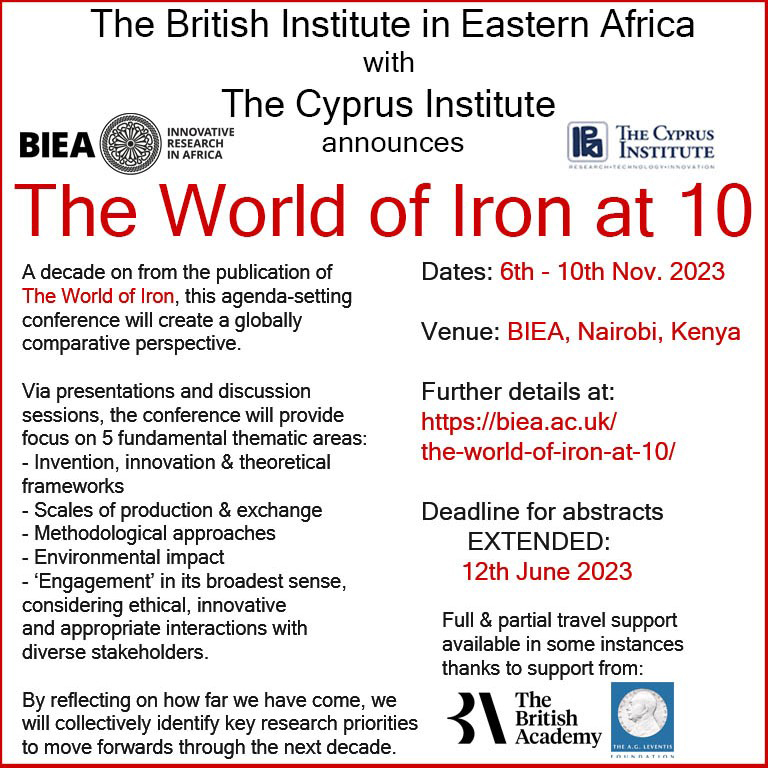
Background
Iron continues to be one of the most important materials we produce and use. For thousands of years its ductility when heated and its strength when cooled has allowed those with the necessary skills and resources, to revolutionise social, ritual, economic and political systems. From enormous buildings such as cathedrals and skyscrapers, to farmers who for millennia have used iron tools to clear land and harvest their crops; and from artful jewellery to instruments of the battlefields, the impact of iron, and its use to overcome broader societal challenges was and is, extraordinary. The diversity of innovative technological approaches to the production of iron is astounding, while traces of the ritual and symbolic nature of this metal bear testament to the mystical and powerful status that iron was often associated with in the past.
In 2009, the first ‘World of Iron’ conference set out to explore and celebrate the anthropological significance of the inception, adoption, expansion, and impact of iron production. Bringing together over 100 archaeometallurgists from around the world to present their multi-disciplinary research, the conference interlaced regional and themed sessions. It encouraged a consideration of the relationship between archaeological and archaeometallurgical studies to wider anthropological issues such as technological style; technical and social adaptation; and the evolving influences of iron on society and the physical environment. Following this successful conference, The World of Iron proceedings were published ten years ago (Humphris and Rehren, eds, 2013). Globally distributed case studies, alongside ethnographic, archaeological, experimental, materials science and anthropological approaches, reveal the rich and diverse history of this metal.
Conference proposal: The World of Iron at 10
Ten years on from the publication, this agenda-setting conference will move beyond the first by facilitating targeted discussion sessions to specifically consider the future of global archaeometallurgy, and how, by reflecting on the state of research in 2023, we can begin to link our findings across space and time to maximise our impact.
The World of Iron at 10 will synthesise the latest highest quality research being conducted across SHAPE and STEM disciplines on iron around the world, implementing a forward-looking format and aiming to develop new connections and foster the emergence of new talent. It will create a globally comparative perspective, integrating insights gained from established and emerging research methods, and provide a dedicated focus on fundamental thematic areas: invention and innovation; theoretical frameworks; scientific approaches; and environmental impact. In addition, attention will be dedicated to the pertinent theme of stakeholder engagement, where we will consider ethical, innovative and appropriate interactions and communication with communities from school children to billion-dollar mining companies with an interest in offloading CSR budget onto our discipline. By reflecting on how far we have come, we will collectively identify key research priorities to move our practice forwards as we continue through the next decade.
The event will advance the discipline of archaeometallurgy via discussion sessions chaired by leaders in the field. For example, Professor Shadreck Chirikure (University of Oxford), whose renowned work on Great Zimbabwe includes utilising Shona cultural perspectives to reinterpret the site (in addition to his extensive archaeometallurgical research portfolio), has agreed to chair Theoretical Frameworks. The Chairs will form the Scientific Committee, led by eminent archaeological material scientist David Killick (Professor of Materials Science and Engineering, University of Arizona), whose seminal work on theory and practice has been instrumental in shaping archaeometallurgical approaches for decades. The provision of travel grants will ensure inclusive, representative and widespread participation, enabling established scholars and young researchers working around the world to stimulate an international exchange of ideas and experiences. Therefore, this well-attended and well-led conference will promote future research of the highest quality by encouraging reflection on the previous years of advances (or stagnation), and brainstorming priority research areas. The collective and collaborative nature of the discussions will in themselves likely lead to new, international, and interdisciplinary research partnerships. For the resulting publication, in addition to the conference papers, each chair will be tasked with writing up these targeted discussions in review articles that will analyse the current situation and suggest important future research foci.
Organisers
– Dr Jane Humphris, Director, BIEA; Senior Research Associate, McDonald Institute, University of Cambridge. – Professor Thilo Rehren, A.G. Leventis Professor for Archaeological Sciences at the Science and Technology in Archaeology and Culture Research Center, The Cyprus Research Institute.
